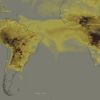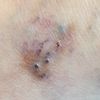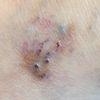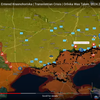Google translate.
@Anonymous fyrir ofan færslu mína, þessar rannsóknir (Recovery and Solidarity and REMAP) voru hannaðar til að drepa sjúklinga til að ófrægja Hydroxychloroquine.
Sumar rannsóknir sem nota hæfilega skammta sýna mjög góða lækkun á dánartíðni, jafnvel hjá viðkvæmum sjúklingum.
Ég ætla ekki að endursegja þetta. Það er of viðkvæmt. Verður að vera rétt.
Reynið að þýða sjálf með
Setja textan inn í Word, ýta á Reviw, ýta á Translate, og velja svo Document eða Selected text
000
Hér er ein commentin, afrituð að neðan úr comments.
000
August 22, 2020 at 8:57 AMAnonymous said...
@Anonymous above my post, these trials (Recovery and Solidarity and REMAP) were designed to kill patients to discredit Hydroxychloroquine.
Some studies using reasonable doses show a very good reduction in mortality, even for vulnerable patients.
If HCQ had not be demonized, there would be no need for a vaccine. There are a couple other cheap drugs being discovered with promising results vs Covid-19 as well
000
Sunday, June 14, 2020
WHO and UK trials use potentially lethal hydroxychloroquine dose--according to WHO consultant
The Solidarity Trial is a WHO-led conglomeration of many national trials of treatments for Covid-19. In March alone, the WHO collected $108 million from donors to cover costs of Solidairy clinical trials. Per the WHO:
As of 3 June 2020, more than 3500 patients have been recruited in 35 countries, with over 400 hospitals actively recruiting patients. Overall, over 100 countries have joined or expressed an interest in joining the trial, and WHO is actively supporting 60 of them...
The hydroxychloroquine arm of the Solidarity trials restarted enrolling patients June 3, after being halted May 25 by WHO Director-General Dr. Tedros Adhanom Ghebreyesus and the Executive Group of the Solidarity Trial. The hydroxychloroquine (HCQ) arm of the trials had been stopped after publication of the Lancet Surgisphere study, which claimed that patients who received chloroquine or hydroxychloroquine had 35% higher death rates, but the Lancet study was retracted 13 days after publication, as its data turned out to be fabricated. The HCQ Solidarity trials are currently ongoing.
Below are the drugs being tested in Solidarity:
- Remdesivir
- Hydroxychloroquine
- Lopinavir with Ritonavir
- Lopinavir with Ritonavir plus Interferon beta-1a.
Initially, the WHO planned to use neither cloroquine in its trials. But multiple countries requested chloroquines, so both chloroquine (CQ) and HCQ were then added to the trial plan. However, HCQ was felt to be a little safer, countries preferred it, so WHO dropped CQ from its trials. Other clinical trials continue to test both CQ and HCQ against Covid-19. The doses were not specified on WHO's list of the drugs to be trialed, nor were they specified, surprisingly, in WHO's April 8 four-person "consultation on chloroquine (CQ) dosing". The Introduction of the Report of that meeting notes,
"The chloroquine or hydroxychloroquine schedule selected for the trial includes two oral loading doses (250 mg per tablet CQ or 200 mg per tablet HCQ), then oral twice-daily maintenance doses for ten days. This meeting convened to discuss the appropriateness of the selected doses for the trial."
Last week, I was alerted to the fact that India's ICMR, its official medical research agency, had written to the WHO, telling WHO that the hydroxychloroquine doses being used in the Solidarity trial were 4 times higher than the doses being used in India. Then I learned that Singapore had been hesitant to participate in the WHO trial due to the hydroxychloroquine dose.
The UK "Recovery" trial was very similar to, but not part of, the international Solidarity conglomeration of clinical trials. The Recovery trial ended its HCQ arm on June 4, reporting no benefit. In-hospital mortality of the 1542 patients receiving hydroxychloroquine was 25.7%, or 396 deaths, about 10% higher than those receiving standard care, a non-significant difference.
The UK Recovery trial Study Protocol notes it is funded in part by the Wellcome Trust and the Bill and Melinda Gates Foundation, and by UK government agencies. The Protocol provides the doses of hydroxychloroquine used, on page 22. Twitter users began to notice a dosing problem, with hashtag #RecoveryGate.
The HCQ dosing regimen used in the Recovery trial was 12 tablets during the first 24 hours (800mg initial dose, 800 mg six hours later, 400 mg 6 hrs later, 400 mg 6 hours later), then 400 mg every 12 hours for 9 more days. This is 2.4 grams during the first 24 hours, and a cumulative dose of 9.2 grams over 10 days.
Even more disturbing than this, babies weighing 5 kg could be given a dose of 300 mg HCQ in the first 24 hours in the UK Recovery trial, which is 233 mg of the base (47 mg/kg), nearly 4 times the recommended maximum. One to two pills (200-400 mg) is "potentially fatal in a toddler". And authors from George Washington University say:
"Ingestion of 1-2 tablets of chloroquine or hydroxychloroquine is thought to predispose children under 6 years of age to serious morbidity and mortality...ingestions of greater than 10 mg/kg of chloroquine base or unknown amounts require triage to the nearest health care facility for 4-6 h of observation. There is very limited data on pediatric hydroxychloroquine overdoses and no reports of toxicity from 1-2 pills, but given its similarity to chloroquine, it also should be considered potentially toxic at small doses. Thus, similar recommendations should be followed for triage after accidental hydroxychloroquine overdose." UPDATE July 21: The American Association of Poison Control Centers said on March 25: "These medications have a narrow therapeutic window, meaning that accidental ingestion of amounts that exceed recommended dosing can be extremely dangerous with toxicity including coma, seizures, cardiac dysrhythmias, low potassium levels, cardiac arrest and death. Even a single pill can be potentially life threatening to a child."
The quote from the WHO report on dosing, provided 9 paragraphs ago, seems to be deliberately vague regarding the dose used in the Solidarity trial, stating the number of milligrams per tablet, but not the number of tablets to be used. The Solidarity trial is registered but the registration fails to specify dosages.
The registration of the Canadian portion of the Solidarity trial informs us of its HCQ dose: ten 200 mg tablets during the first 24 hours (800 mg initial dose, 800 mg 12 hours later then 400 mg every 12 hours for 9 more days). This is 2.0 grams during the first 24 hours, and a cumulative dose of 8.8 grams over 10 days, or only 0.4 grams less than what Recovery used. The Norwegian Solidarity trial uses dosing identical to Canada.
Co-Principal Investigators of the Recovery trial, Drs. Peter Horby and Martin Landray, said they followed the WHO dosing. This is what their trial document says as well, on page 23. Landray also claimed in an interview with Paris Soir that the maximum allowed HCQ dose was "6 or 10 times" the dose used in Recovery, and that he was using the hydroxychloroquine dose that is used for amebic dysentery. However, the accepted use for HCQ in amebiasis is only for a liver abscess and only then in pregnancy, when other drugs cannot be used. That dose is 600 mg per day for 2 days, then 300 mg per day, considerably less than half the Recovery dose. Co-Principal Investigator Peter Horby said that Paris Soir misinterpreted Landray's comments, but Paris Soir said Landray had confirmed what he told them in an email prior to publication. Landray is a very busy man, too busy, apparently, to look up the proper dose of a drug he gave to over 1500 subjects, who were randomized to the treatment and had no say in the matter.
We know that in Brazil, both a high CQ dose and a low CQ dose were trialed, and by April 17 the high dose arm was stopped prematurely due to an excess of deaths, with 39% mortality (16 deaths in 41 subjects). The mean age in the high dose group was 54.7. The high dose arm used 600 mg CQ twice daily for ten days, with cumulative dose of 12 grams. EKG changes typical of toxicity were seen in 25% of high dose subjects. The low dose trial continues in Brazil.
How is the drug hydroxychloroquine normally used? For chronic daily use in systemic lupus erythematosus, rheumatoid arthritis or Lyme disease, patients receive between 200 and 400 mg daily, or a maximum of 5 mg/kg. In acute Q fever, 600 mg daily may be given at the start of treatment. For acute attacks of malaria, 1,500-2,000 mg may be given over 3 days. Professor Didier Raoult's group in Marseille used 600 mg daily for up to ten days in 1061 Covid-19 patients, and reported 8 deaths, a mortality rate of 0.75%, all over 74 years of age. The mortality rate reported by Landray and Horby in the Recovery trial is 34 times higher.
We know from WHO's March 13 Informal consultation on the potential role of chloroquine that the Gates Foundation had been studying the drug's complex pharmacokinetics, and of the 25 participants at this meeting, 5 were from the Gates Foundation.
The only treatment dose mentioned in the March 13 Informal consultation report was in a paragraph about preventive doses. It said, "Higher doses would be considered for treatment, i.e., 10mg/kg base, followed by 5mg/kg twice daily for seven days."
What is the "base"? A 200 mg dose of hydroxychloroquine contains 155 mg "base" drug. Generally, a loading dose refers only to a high first dose, not to several high additional doses. However, the trial protocol used in Solidarity employs the same dose for all, rather than weight-based dosing.
What is a toxic dose? All experts agree on this: "... chloroquine has a small toxic to therapeutic margin," according to Goldfrank's Toxicologic Emergencies. The drug is very safe when used correctly, but not a lot more can potentially kill. Prof. Nicholas White, a Wellcome Trust Principal Research Fellow and expert in malaria treatment, who attended both WHO consultations on the chloroquines, has confirmed this. Careful monitoring of electrolyte levels and an EKG can prevent most problems.
The WHO hired a consultant to explore the toxicity of chloroquine in 1979. The consultant, H. Weniger, looked at 335 episodes of adult poisoning by chloroquine drugs. Weniger on page 5 notes that a single dose of 1.5-2 grams of chloroquine base "may be fatal."
According to Browning and Goldfrank, the pharmacokinetics and potency of chloroquine and hydroxychloroquine are almost identical, while the maximum used chronic dose of chloroquine is 3.5 mg/kg.
The Recovery trial used 1.86 grams hydroxychloroquine base (equal to 2400 mg of hydroxychloroquine) in the first 24 hours for treatment of already very ill, hospitalized Covid-19 patients. The Canadian and Norwegian Solidarity trials used 2,000 mg of HCQ, or 1.55 grams of HCQ base in the first 24 hours. Each trial gave patients a cumulative dose during the first 24 hours that, when given as a single dose, has been documented to be lethal. (The drug's half-life is about a month, so the cumulative amount is important.)
The doses used in these trials are not recommended for therapy of any medical condition, which I confirmed with Goodman and Gilman's Pharmacology textbook, the drug's US label, and the online subscription medical encyclopedia UptoDate.
Excessive, dangerous HCQ dosing continues to be used in WHO's Solidarity trials. While the Solidarity trials have an "adaptive" design which allows midstream protocol changes, no lessons were learned from the Brazil or Recovery trials' experience with excessive dosages. Solidarity has not reduced its HCQ dosing, although it can do so at any time. The Solidarity trials are not, in fact, testing the benefits of HCQ on Covid-19, but rather are testing whether patients survive toxic, non-therapeutic doses.
The WHO Solidarity trials, in order to rapidly enroll patients and spare clinicians a lot of paperwork, collect only limited information on side effects. No information has yet been provided regarding causes of death in the completed hydroxychloroquine arm of the Recovery trial, in which 396 patients died, and may never be.
The Solidarity trial design being employed by WHO obscures whether mortality is due to drug toxicity (in which case, one would expect death to be due to an arrhythmia, neuropsychiatric effects, or hypoglycemia) as opposed to death due to Covid-19.
In fact, the lack of safety data being collected is downright scary. Here is a description of the data obtained on patients enrolled in Solidarity, as reported in Science magazine:
The participant has to sign an informed consent form that is scanned and sent to WHO electronically. After the physician states which drugs are available at his or her hospital, the website will randomize the patient to one of the drugs available or to the local standard care for COVID-19. “After that, no more measurements or documentation are required,” says Ana Maria Henao Restrepo, a medical officer at WHO’s Emergencies Programme. Physicians will record the day the patient left the hospital or died, the duration of the hospital stay, and whether the patient required oxygen or ventilation, she says. “That’s all.”
The WHO report of its meeting on chloroquine dosing states,
Although the preponderance of opinion tilted towards a reasonable benefit risk profile for the intervention, there was some scepticism about what was considered a ‘minimalistic safety data collection’ currently included in the protocol.
The high dose regimen being used in these trials has no medical justification. The trial design, with its limited collection of safety data, makes it difficult or impossible to identify toxic drug effects, compared to a standard drug trial. This is completely unethical.
Excessive dosing makes it impossible to assess therapeutic benefit, if any, of HCQ. Furthermore, because there are over 400 trial sites, and relatively few subjects in each, unexpectedly high trends in mortality are likely to be missed at individual trial sites.
Finally, testing the drug only in hospitalized patients means that the window of time during which HCQ would be expected to provide the most benefit, early in the illness when viral titers are rising, has passed.
Didier Raoult's group has recently published on the major differences in treatment and outcomes patients receive when placed in "big data" studies vs. receiving individualized care for Covid-19.
As I was completing this article, the FDA announced it was withdrawing its Emergency Use Authorization for hydroxychloroquine in Covid-19, because the "known and potential benefits" no longer outweigh the risks of the drug. The FDA cited data from the Recovery trial in its announcement. I discuss the implications here.
To sum up:
- 1. In the UK Recovery trial, and in WHO Solidarity trials, HCQ is used in a non-therapeutic, toxic and potentially lethal dose.
- 2. HCQ is furthermore being given, in clinical trials, too late in the disease course to determine its value against SARS-CoV-2.
- 3. Collection of limited safety data in the Solidarity trials serves to protect trial investigators and sponsors from disclosures of expected adverse drug effects, including death.
- 4. It appears that WHO has tried to hide information on the hydroxychloroquine doses used in its Solidarity trial. Fortunately, the information is discoverable from registries of its national trials.
- 5. The conclusions to be drawn are frightening:
- a) WHO and other national health agencies, universities and charities have conducted large clinical trials that were designed so hydroxychloroquine would fail to show benefit in the treatment of Covid-19, perhaps to advantage much more expensive competitors and vaccines in development, which have been heavily supported by Solidarity and Recovery trial sponsors and WHO sponsors.
- b) In so doing, these agencies and charities have de facto conspired to increase the number of deaths in these trials.
- c) In so doing, they have conspired to deprive billions of people from potentially benefiting from a safe and inexpensive drug, when used properly, during a major pandemic. This might contribute to prolongation of the pandemic, massive economic losses and many increased cases and deaths. Update June 18: I sent a tweet to WHO Director General Tedros informing him of these findings 3 days ago. I also emailed WHO's Dr. Restrepo, inquiring about the doses used in the Solidarity trial. I am very pleased to report thatWHO stopped this deadly trial yesterday, with no fanfare. WHO claimed the decision was made on the basis of the Recovery trial result and a Cochrane review, as well as WHO data. One wonders if the DSMB was bypassed again, as occurred on May 25 when WHO halted its HCQ arm for the first time. I had pointed out that if trial investigators had not disclosed to subjects the known risks associated with the high HCQ doses used, the investigators and WHO would be liable for damages. I like to think my investigation has helped save some lives.
Posted by Meryl Nass, M.D. at 9:17 AM
8 comments:
John said...
Mind boggling to think Anne Frank if alive could be in these high dose HCQ WHO studies.
Doctors here earned deserving mistrust on level that defies comprehension.
Dr Mengele’s School of Medicine in many ways has won the day, and honest physicians could not disregard how high the mountain piles in nearly ever direction of MD Mengele facts!!!
Physicians themselves report don’t know what to do about the corruption coming from those in charge!!
Reading about another pile in Bitten on Lyme Disease Kris Newby on Biological Weapons for citizens, the thrill of it all.
Mr. Hilter election Pls Monty Pythons Flying Circus https://m.youtube.com/watch?v=hWIyVRNAxCg&feature=emb_title
Caution Killers https://www.youtube.com/watch?v=vLL5igJOsXo
Human Race Matters?
June 18, 2020 at 12:05 AMUnknown said...
This is an article of exceptional quality. We quickly came to the conclusion that the RECOVERY trials were an act of sabotage. We, however, did not look at the dosage to infants and children. The RECOVERY trials recommend a toxic dose of hydroxychloroquine to infants. Neither infants nor breastfeeding mothers should be administered hydroxychloroquine according to the insert of the manufacturer for the US. It is shocking that the RECOVERY protocol contains such a gross and potentially deadly error. Thank you for your excellent work. The New Neander's Medical.
June 18, 2020 at 9:07 AMDrew458 said...
I hope that President Trump keeps his mouth shut about the news of Dexamethasone. That too will become instant anathema if he so much as nods his head in it's direction.
June 18, 2020 at 12:22 PMAnonymous said...
A very scary and well researched article of evidence to show Cov-19 was made in the USA Not a quick read, so you may want to skip the history of viruses and scroll to: Man-Made SARS-CoV-2 https://www.sott.net/article/437083-Compelling-Evidence-That-SARS-CoV-2-Was-Man-Made
June 28, 2020 at 12:01 PMAnonymous said...
The Elephant in the room is what boys and girls ….?
http://www.rigorousintuition.ca/board2/viewtopic.php?f=8&t=41979
Breadcrumbs.
Uncanny similarity of unique inserts in the 2019-nCoV spike protein to HIV-1 gp120 and Gag
Prashant Pradhan, Ashutosh Kumar Pandey, Akhilesh Mishra, Parul Gupta, Praveen Kumar Tripathi, Manoj Balakrishnan Menon, James Gomes, Perumal Vivekanandan, Bishwajit Kundu
This article is a preprint and has not been certified by peer review [what does this mean?]. AbstractFull TextInfo/HistoryMetrics Preview PDF Abstract
We are currently witnessing a major epidemic caused by the 2019 novel coronavirus (2019-nCoV). The evolution of 2019-nCoV remains elusive. We found 4 insertions in the spike glycoprotein (S) which are unique to the 2019-nCoV and are not present in other coronaviruses. Importantly, amino acid residues in all the 4 inserts have identity or similarity to those in the HIV-1 gp120 or HIV-1 Gag. Interestingly, despite the inserts being discontinuous on the primary amino acid sequence, 3D-modelling of the 2019-nCoV suggests that they converge to constitute the receptor binding site. The finding of 4 unique inserts in the 2019-nCoV, all of which have identity /similarity to amino acid residues in key structural proteins of HIV-1 is unlikely to be fortuitous in nature. This work provides yet unknown insights on 2019-nCoV and sheds light on the evolution and pathogenicity of this virus with important implications for diagnosis of this virus.
Breadcrumbs.
https://www.biorxiv.org/content/10.1101/2020.01.30.927871v1
July 3, 2020 at 10:41 AMUnknown said...
in reply to Anonymous: "The Elephant in the room is what boys and girls ….?" and "Uncanny similarity of unique inserts in the 2019-nCoV spike protein to HIV-1 gp120 and Gag"
***PAPER WITHDRAWN***
read the comments on it at https://www.biorxiv.org/content/10.1101/2020.01.30.927871v1
it's total rubbish, basically.
July 13, 2020 at 8:48 AMAnonymous said...
I think the same trials should not be continued because they are too risky to human health. Do you think a vaccine is more practical, at least it has no effect on health? Remember to visit my blog if you have some time: สล็à¸à¸•
August 22, 2020 at 8:57 AMAnonymous said...
@Anonymous above my post, these trials (Recovery and Solidarity and REMAP) were designed to kill patients to discredit Hydroxychloroquine.
Some studies using reasonable doses show a very good reduction in mortality, even for vulnerable patients.
If HCQ had not be demonized, there would be no need for a vaccine. There are a couple other cheap drugs being discovered with promising results vs Covid-19 as well
Subscribe to: Post Comments (Atom)







Bæta við athugasemd [Innskráning]
Ekki er lengur hægt að skrifa athugasemdir við færsluna, þar sem tímamörk á athugasemdir eru liðin.